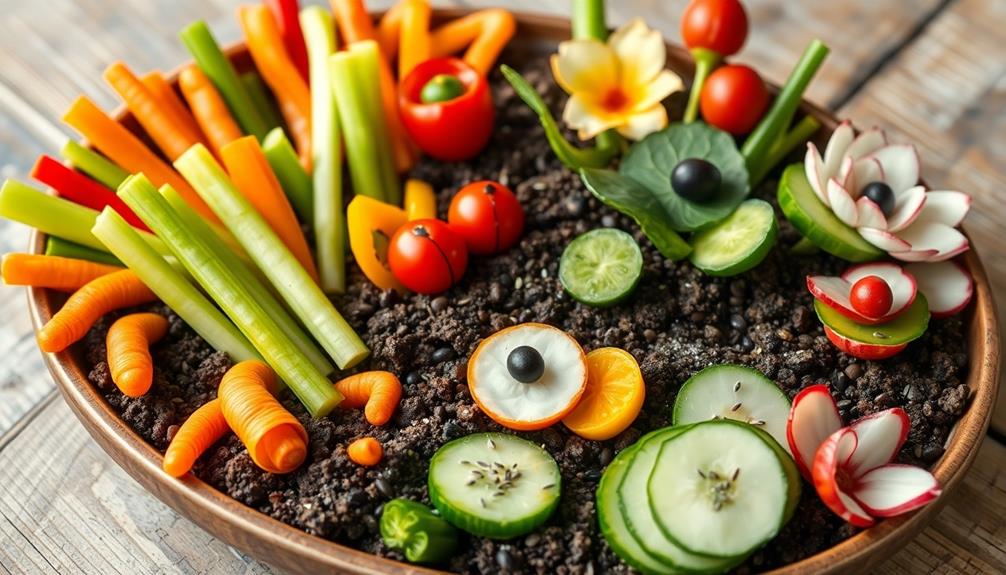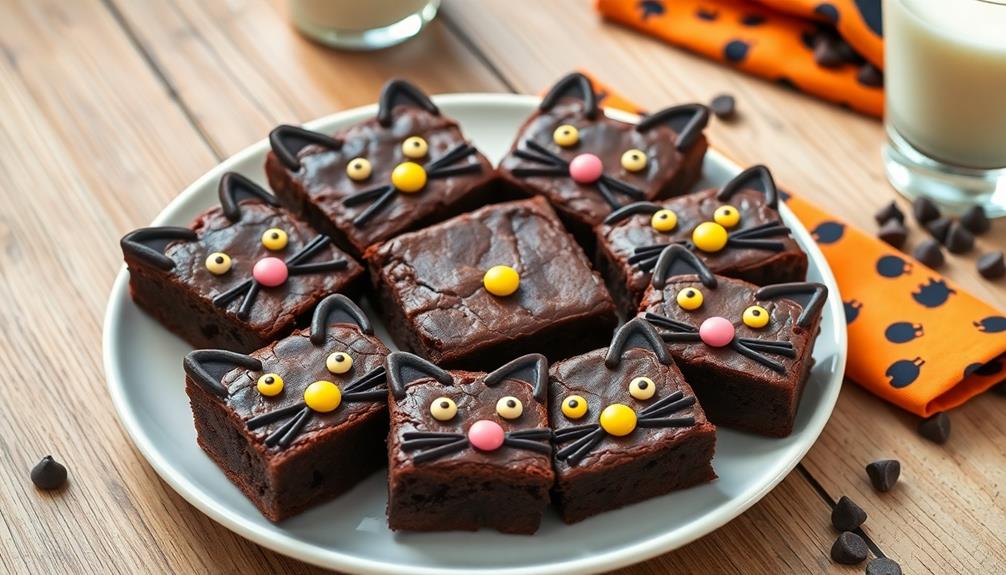Fresh pumpkin puree offers a brighter flavor, richer aroma, and thicker, chunkier texture, perfect for adding natural sweetness to dishes. Canned puree is smoother, more convenient, and has a milder aroma, making it ideal for quick recipes. Both provide nutritious benefits, but their differences in flavor and texture can impact your cooking outcome. To choose the right option, consider your recipe and convenience—exploring more will help you get the best results.
Key Takeaways
- Fresh pumpkin puree offers a vibrant aroma, natural sweetness, and thicker texture, while canned puree provides a smooth, uniform consistency.
- Both types are nutritionally rich, with fresh puree potentially retaining slightly higher antioxidant levels due to minimal processing.
- Fresh puree requires proper storage, quick use, or freezing, whereas canned pumpkin is shelf-stable and ready to use immediately.
- Fresh puree is ideal when seeking vibrant flavor and texture, while canned is more convenient for year-round baking and cooking.
- Selection depends on recipe needs, seasonality, and preference for freshness versus convenience.
Differences in Flavor Profiles
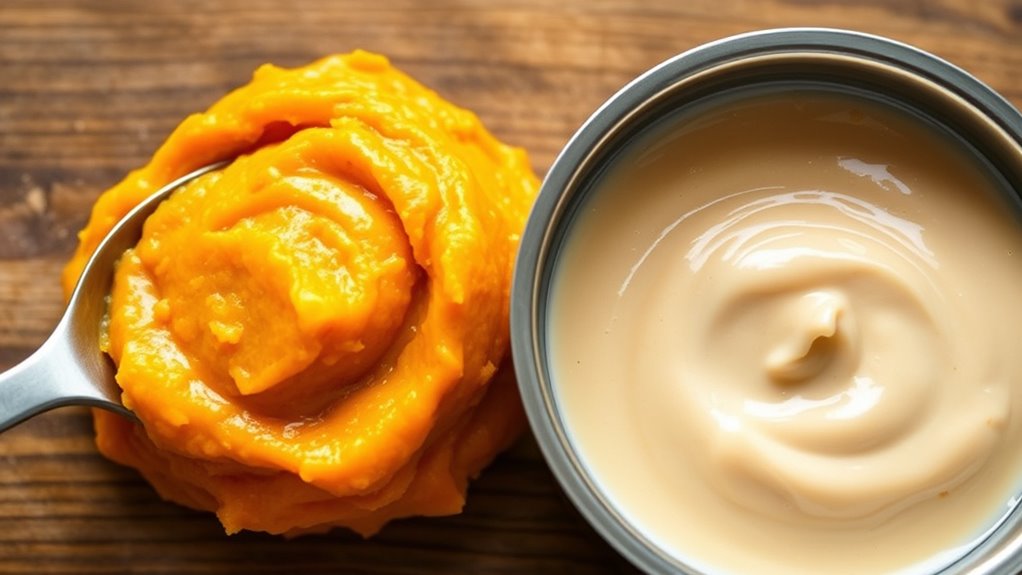
While all pumpkin purees come from the same fruit, their flavor profiles can vary considerably depending on the variety and processing method. You’ll notice subtle flavor nuances that can influence your recipes, from sweet and nutty to more earthy tones. Fresh pumpkin puree often delivers a fresher, more vibrant aroma, with a natural sweetness that’s less muted. Canned pumpkin, on the other hand, tends to have a more muted aroma, sometimes with hints of added spices or preservatives that impact its flavor nuances. These aroma differences can affect the overall depth of your dishes, especially baked goods and soups. Understanding these subtle distinctions helps you choose the right puree to achieve the desired flavor complexity in your culinary creations. Processing methods can also influence the final flavor, as dehydration and preservation techniques may alter natural tastes.
Texture and Consistency Variations

The texture and consistency of pumpkin puree can vary considerably depending on how it’s prepared and processed. Fresh puree tends to be thicker and chunkier if not blended thoroughly, while canned puree usually offers a smooth, uniform texture. To adjust consistency, you can add liquids like broth or milk for thinner results or cook it longer to thicken. Seasoning suggestions, such as cinnamon or nutmeg, can enhance flavor without affecting texture, but adding butter or oil can make it creamier. Proper storage tips are essential—store fresh puree in an airtight container in the refrigerator for up to three days or freeze it for longer shelf life. Additionally, monitoring the filter condition of your kitchen appliances can help ensure the freshness and safety of your ingredients. This ensures your pumpkin puree maintains the desired texture, flavor, and freshness for your recipes.
Nutritional Content Comparison

Pumpkin puree is a nutritious addition to your meals, offering a variety of health benefits depending on its source. When comparing fresh and canned pumpkin, you’ll notice differences in fiber content and antioxidant levels. Fresh pumpkin often retains more fiber because it’s less processed, helping support digestion and fullness. Canned pumpkin, however, still provides significant fiber but may have slightly lower levels due to processing. Both forms are rich in antioxidants like beta-carotene, which promotes eye health and immune function. The antioxidant levels are generally comparable, although fresh pumpkin might have a slight edge because of minimal processing. Overall, both options deliver essential nutrients, so your choice depends on convenience, but you won’t miss out on crucial nutrients regardless of whether you opt for fresh or canned pumpkin.
Preparation and Cooking Processes
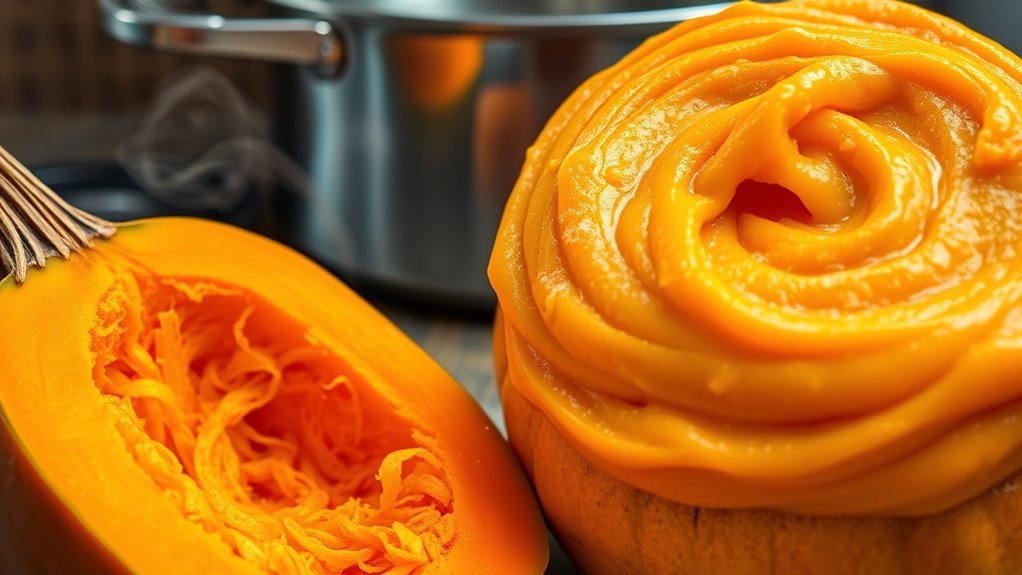
You’ll want to start by choosing fresh pumpkins and preparing them properly, whether by peeling, seeding, or chopping. Next, consider different canning and processing methods to preserve your puree effectively. Finally, explore various cooking techniques like roasting, boiling, or steaming to achieve the best flavor and texture. Additionally, maintaining proper storage conditions can prolong shelf life and ensure your pumpkin puree remains safe and flavorful.
Fresh Pumpkin Preparation
To prepare fresh pumpkin for puree, start by selecting a ripe, firm pumpkin with a deep color. Proper seed selection is important; choose pumpkins with healthy, unblemished seeds if you plan to save them for planting or roasting. Harvest timing plays a key role—pick pumpkins when they’re fully mature, usually in late summer or early fall, to ensure maximum sweetness and flavor. Once harvested, wash the pumpkin thoroughly to remove dirt and debris. Cut off the stem and slice the pumpkin in half or into manageable pieces. Remove the seeds and stringy pulp if you prefer a smoother puree. You can then roast or steam the pumpkin until tender, ready for pureeing into a smooth, fresh pumpkin puree.
Canning and Processing Methods
Before canning or processing pumpkin puree, it’s vital to prepare the pumpkin properly. Start by selecting ripe, healthy pumpkins and thoroughly cleaning them. To guarantee safety and quality, use proper storage techniques—store pumpkins in a cool, dry place before processing. When processing, focus on pasteurization methods to eliminate bacteria and enzymes. Heat the puree to the recommended temperature for the appropriate time, which helps preserve flavor and prevents spoilage. Use sterilized jars or containers, leaving appropriate headspace to accommodate expansion during processing. Proper canning techniques, such as hot water bath or pressure canning, are essential for long-term storage. Once sealed, store your canned pumpkin in a cool, dark location, making sure it remains fresh and safe for months. Incorporating Proper canning techniques ensures your pumpkin preserves safely and maintains quality over time.
Cooking Techniques Comparison
Different cooking techniques can considerably influence the flavor, texture, and nutritional qualities of pumpkin puree. Roasting enhances the seasonal flavor, giving it a rich, caramelized depth, while steaming preserves moisture and nutrients, resulting in a smoother texture. Boiling is quick but can dilute flavor and diminish nutrients; baking intensifies sweetness and adds a slightly smoky note. Microwaving offers convenience and retains freshness, ideal for quick recipes. The method you choose impacts the culinary versatility of your puree, shaping its role in pies, soups, or sauces. Understanding cooking methods can help you select the best technique for your desired outcome.
Convenience and Shelf Life
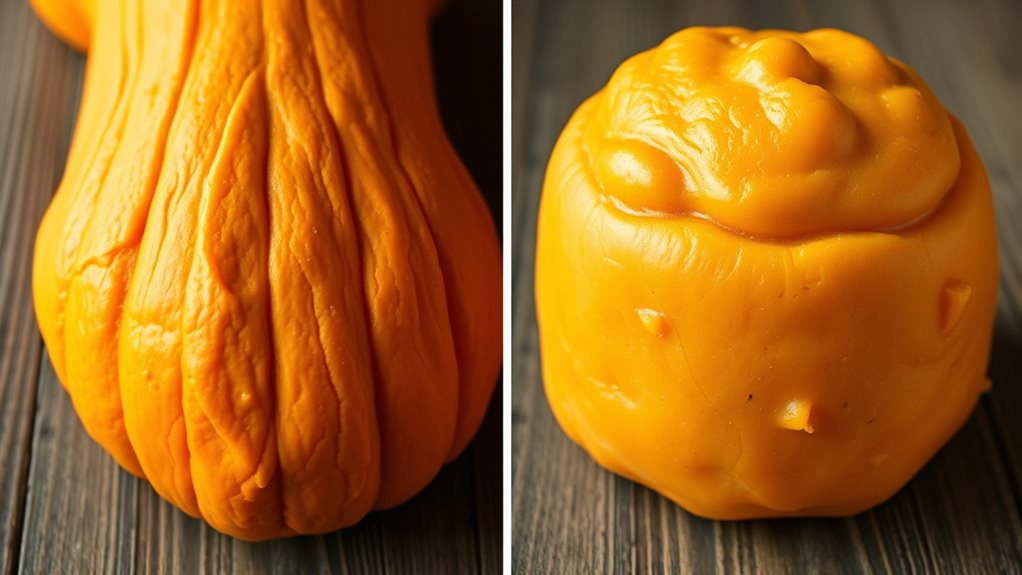
Convenience is one of the main reasons many people choose pumpkin puree, as it simplifies recipes and saves preparation time. Canned pumpkin offers excellent packaging convenience, with resealable lids that make storage straightforward. It also boasts impressive storage longevity, often lasting months in your pantry without spoiling. Fresh pumpkin puree, on the other hand, requires refrigeration and consumes more space, with a shorter shelf life—typically a few days to a week. If you prefer quick, hassle-free options, canned puree provides an easy, reliable solution. Fresh puree, while slightly less convenient, needs proper storage and prompt use to prevent spoilage. Overall, canned pumpkin’s packaging convenience and extended shelf life make it a popular choice for those seeking convenience. Additionally, Volkswagen Tuning techniques highlight how proper storage and handling can optimize the quality and longevity of perishable products like fresh pumpkin.
Best Uses in Baking and Cooking
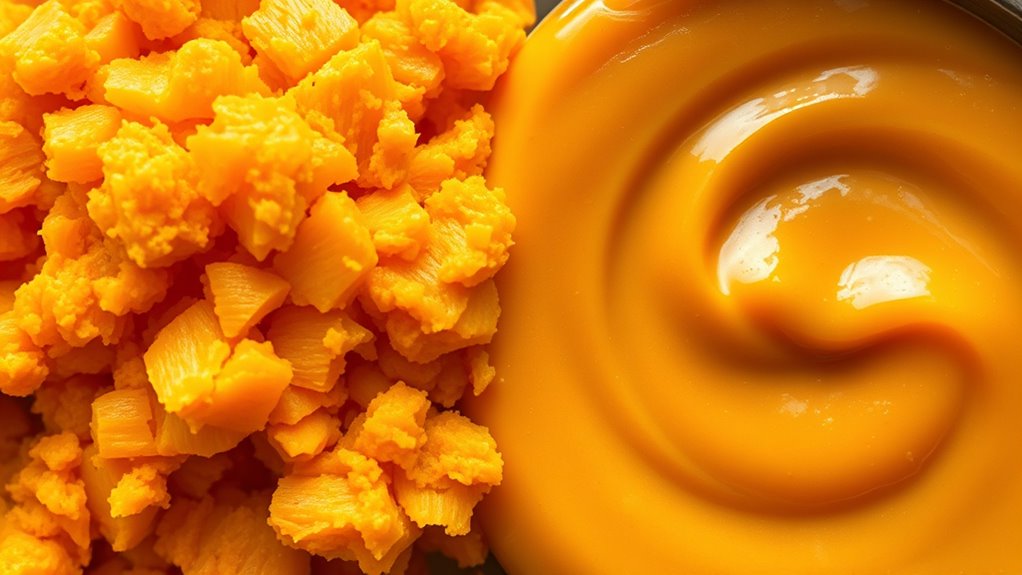
Pumpkin puree is a versatile ingredient that enhances a wide range of baked goods and savory dishes. You can use it to add moisture, richness, and a subtle sweetness to your recipes. It’s perfect for seasonal recipes like pies, muffins, and bread, where it provides flavor enhancement and a cozy fall vibe. In savory dishes, pumpkin puree works well in soups, stews, and sauces, adding depth and creaminess. You might also try incorporating it into smoothies or dips for added nutrition. Its smooth texture and mild flavor make it easy to mix into various recipes, expanding your culinary options. Whether fresh or canned, pumpkin puree brings warmth and richness, making your dishes more flavorful and memorable. Additionally, using pumpkin puree can promote mindfulness and presence during cooking, turning meal preparation into a calming, creative ritual.
Cost and Availability Factors
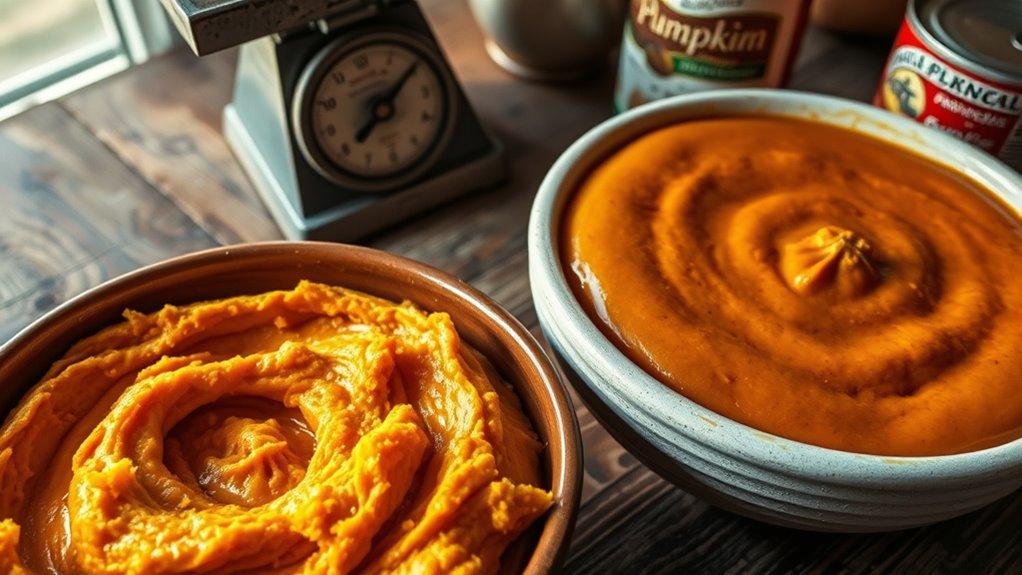
Have you noticed how the cost and availability of pumpkin puree can vary throughout the year? Market availability often depends on the season, with fresh pumpkin puree being more plentiful and affordable during fall harvests. Outside of peak season, canned pumpkin tends to be your only option, and pricing fluctuations can occur due to supply chain issues or increased demand. During off-peak months, canned puree might be pricier and harder to find in some areas. Conversely, in the fall, you’ll likely see a wider selection and better prices. If you’re planning ahead, buying canned pumpkin during its off-season can help you save money, but fresh puree may be more accessible and cost-effective during harvest time. Top 10 anime films recommended for fans can also influence your seasonal shopping preferences.
Tips for Selecting the Right Pumpkin Puree

Choosing the right pumpkin puree depends on your specific needs and how you plan to use it. Consider seasonal availability; fresh pumpkins are best during fall, while canned options are convenient year-round. When selecting, look for puree with a smooth, uniform texture and no added sugars or preservatives. Fresh pumpkin puree requires proper storage tips—keep it refrigerated and use within a few days or freeze for longer storage. Canned puree, on the other hand, has a long shelf life and is ready to use straight from the can. To ensure quality, check labels carefully and opt for organic or minimally processed options if possible. Your choice should align with your recipe, storage capabilities, and preference for freshness versus convenience. Additionally, selecting keto-friendly ingredients can help maintain your low-carb diet while enjoying pumpkin’s flavor and nutrients.
Creative Ways to Use Both Types
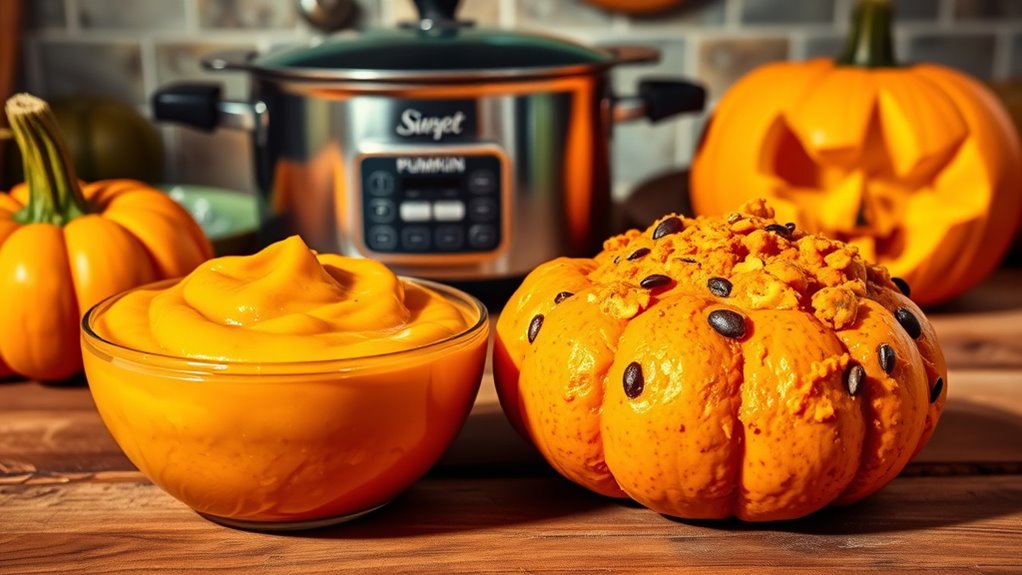
Whether you’re using fresh or canned pumpkin puree, there are plenty of creative ways to incorporate it into your cooking and baking. You can add it to seasonal recipes like soups, stews, or muffins for a rich, comforting flavor. Try blending pumpkin into smoothies or oatmeal for a nutritious twist. It pairs well with spices like cinnamon, nutmeg, and ginger, enhancing fall-inspired dishes. Use pumpkin as a filling for pies, tarts, or pancakes, or mix it into pancake batter for added moisture and flavor. For savory options, combine pumpkin with sage or rosemary in pasta sauces or risottos. The versatility of pumpkin puree allows you to experiment with flavor pairings and seasonal recipes, making your dishes both delicious and visually appealing. Incorporating pumpkin into your meals can also support nutritional benefits and add a vibrant color to your plate.
Frequently Asked Questions
Can You Substitute Canned Pumpkin Puree in All Recipes Calling for Fresh?
Yes, you can substitute canned pumpkin puree in all recipes calling for fresh pumpkin, but keep in mind that seasonal pumpkin varieties and pumpkin puree consistency differ. Canned puree is smoother and more uniform, while fresh pumpkin may have a chunkier texture. To guarantee the best results, blend fresh pumpkin until it reaches a similar consistency as canned puree before using it in your recipes.
How Does the Sweetness Level Differ Between Fresh and Canned Pumpkin Puree?
Think of the sweetness level as a gentle rollercoaster; canned pumpkin tends to be sweeter than fresh. You’ll notice a richer, more concentrated flavor profile because processing boosts natural sugars. Fresh pumpkin, with its milder, earthier taste, has less sweetness. When baking, consider this difference—you might need to adjust added sugar to balance the flavor profile and achieve your desired sweetness level.
Are There Any Additives in Canned Pumpkin Puree I Should Be Aware Of?
Canned pumpkin puree usually contains preservatives or additives to extend shelf life and prevent spoilage. You should check the label for additive concerns, as some brands include preservatives, stabilizers, or added sugars. If you’re sensitive or prefer a more natural product, opt for brands that list only pumpkin as the ingredient. Always read labels carefully to guarantee the preservative content aligns with your dietary preferences.
Is Homemade Pumpkin Puree Safe to Freeze for Long-Term Storage?
Ever wondered if homemade pumpkin puree is safe to freeze for long-term storage? Absolutely! Proper freezing techniques and preservation methods guarantee its safety and quality. First, you should puree the cooked pumpkin, then store it in airtight containers or freezer bags, removing excess air. Label and date your containers, storing at 0°F or below. This keeps your puree fresh for up to three months, making it perfect for future recipes.
What Are the Best Pumpkins to Use if Making Fresh Puree at Home?
You should choose sugar pumpkins or pie pumpkins for making fresh puree, as they have sweet, dense flesh ideal for pureeing. Look for organic varieties if you want a natural, pesticide-free option. Select pumpkins with a firm, unblemished skin and a sturdy stem. These pumpkins are easier to work with and yield a rich, smooth puree perfect for baking or soups. Avoid large carving pumpkins, as they don’t produce the best flavor or texture.
Conclusion
Whether you choose fresh or canned pumpkin puree, you’re revealing a world of autumnal magic that can transform your recipes into culinary masterpieces. Embrace the rich, velvety textures and vibrant flavors as if they’re treasures from a pumpkin fairy’s treasure chest. With each spoonful, you’re conjuring cozy fall nights, pumpkin-spiced dreams, and unforgettable moments—so go ahead, make every dish a celebration of pumpkin perfection that’ll leave everyone in awe!



